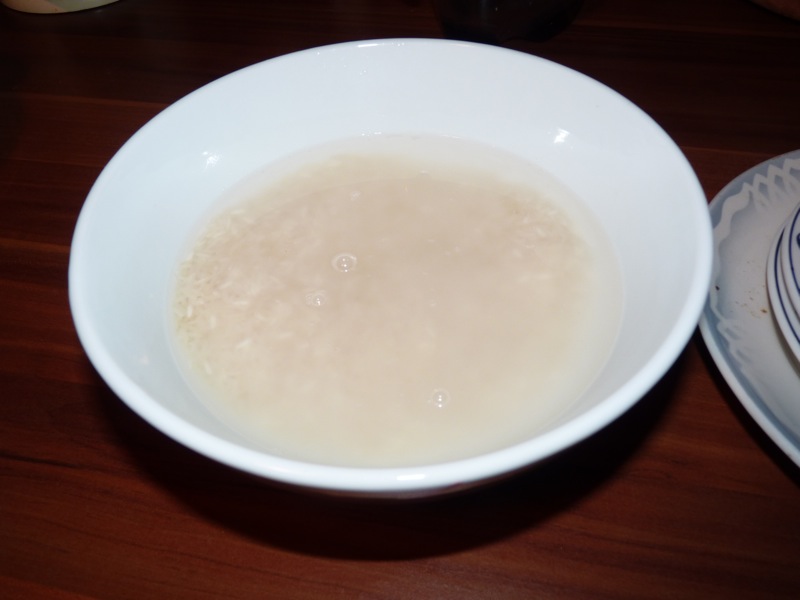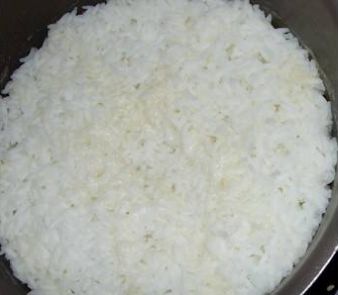Basic Rice Cooking and Handling
How to cook rice the Vietnamese way.

Recipe type: Basics
Cuisine: Vietnamese
(mostly posting this because a couple of people, including desperance, were interested. This is cooking 101–I knew how to do this before I left my parents’ house, and God knows I knew next to nothing cooking-wise back then–so don’t expect any great revelations…)
So… rice. I was 20, I think, when I realised that the way I’d learnt to cook rice didn’t correspond to what the majority of French people expected. The French way of cooking rice is a bit like cooking pasta: boil water with salt, put rice in water, drain in a colander.
Which is pretty close to a heresy in my book (and in a looot of other people’s books if they’re not French), so as I promised: here’s the way I cook rice. As usual, making no particular claims; just what I learnt (and adjusted).
Picking your rice: what I always get is jasmine rice, the new crop if it’s that time of the year (though be aware the new crop isn’t as dry as the older ones, which means you might need slightly less water. We’ll come back to that later). You can cook jasmine rice on a stove with a basic nonstick saucepan; some varieties, such as Japanese rice and glutinous rice, can’t be handled that way (you need to steam it in a special container, or to have a rice cooker).
Whatever you pick, get starchy rice, and not the varieties that come with the starch all but removed like Uncle Ben’s or the stuff that’s on Western supermarket shelves. Arborio is also unsuitable for this; and I’ve had variable luck with Basmati, which sometimes has a tendency to burn the bottom of the pan; I suspect the rice needs way more water than the jasmine, but I could be wrong about this…
Storage: store rice in a cool dry place, away from light. You don’t want beasties getting into it; otherwise it’ll keep almost forever, but will lose its fragrance as time passes (I once ate rice that was 3-4 years old. Not bad, but kind of funky–like everything was off with it). My maternal grandmother mixes 9/10 jasmine rice, 1/10 glutinous rice; which gives a nicer texture once it’s cooked.
Rinsing rice: you need to rinse the rice before you cook it, to get rid of the excess starch. Rinsing is probably a misnomer, because it’s more a case of washing. Basically, take the amount of rice you want, put it in a casserole dish or a bowl, put some water, swirl the rice around a bit until the water gets opaque. Dump the water, put more water, rinse again, and so on for a few rounds. Most of the time I stop at 4, but that’s because I’m lazy. (I was always told 7 times was the right number). A lot of cookbooks will advise you to rinse the rice until the water runs clear. That’s an exaggeration: the water never gets clear. (rice is mostly starch, and the water gets clouded with starch. If it didn’t, it would be because you’d removed the starch altogether…). You HAVE to rinse the rice, otherwise the flavour will be lost in the starch excess. Especially jasmine rice, which has a delicate aroma that is easily crushed.
Quantities? I’m not crazy about the imperial system, but rice is definitely a staple you measure by volume, and not by weight. I use 300mL of uncooked rice for a 2-person meal, which is 1.5 rice cooker cup (note that a rice cooker cup is around 200mL, unlike an imperial measuring cup).
Adding water: now that the rice has been washed, put it into your pan. A nice, thick bottom is a good idea, in order to spread the heat evenly; and a nonstick pan is also a good idea, because there’s still starch in your rice, and the grains are going to cling like limpets to the bottom of the pan. Then measure out 1.25 times the volume of rice in water: if you put 1 cup rice, add 1.25 cup water, and so on. (I tend to adjust a bit depending on how old–and dry–the rice has got).
Steam cooking: cook on high heat (the water should be boiling) until the “eyes” form. The rice is still wet, but lots of little holes are beginning to form as the steam lifts from the grains.
Final cooking: when the “eyes” form, turn the heat to the lowest setting you have. Cover, and leave to cook for about 20 minutes. Don’t lift the lid during that time, or the steam will escape: I was always told this would ruin the rice. I suspect what really happens is that the water goes away, and the rice burns on the bottom. Plus, dry rice just doesn’t taste very good.
A word of warning: I’ve not tried any of that on a gas stove (me and gas don’t get along), so you might need to adjust a bit. Also, from my mom’s experience, cooking rice on an induction stove is a little trickier. I suspect it’s because the temperature of the pan adjusts more or less instantly when you turn off the heat, and the final cooking stage is much more difficult when you can’t count on the residual heat from the pan itself. If anyone wants to chip in with induction stove experience, feel free!
And if you have any questions/comments/disagreements, please do post them.
